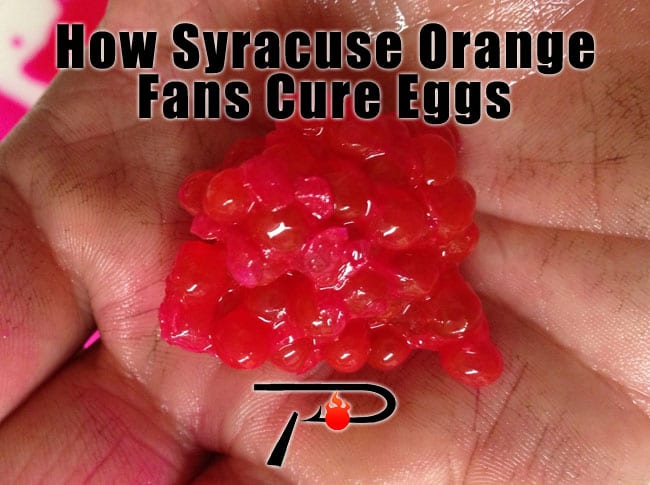Spawn
How Syracuse Orange Fans Cure Eggs
By Andy Bliss | 08/26/2013
How We Cure Eggs For Lake Ontario Tribs
I spend my fall fishing Lake Ontario tributaries for salmon and I like my eggs to be on the tough side when I fish places like the Oswego River, which has heavy current. However, if I was fishing places with less current, I like a wetter, juicer egg. That wetter egg disperses more scent.
I want my eggs to be as bright of a pink as I can get them to be. We get them on natural and red, but pink is our go-to color around here. I’d say 90 percent of the kings I catch come on pink eggs.
Almost as important as a well cured egg is the size you choose to cast. When targeting salmon I use larger pieces than when I fish for steelhead, but not huge ones. The reason why we don’t use large chunks is with the faster water I fish it gets caught in the current and breaks apart quicker. I use about a quarter-size piece.
How The (Syracuse) Orange Cure Eggs
Step 1: Bleed Salmon Properly
Most importantly, you need to start with a fresh skein. A perfectly cured egg starts on the water. As soon as you catch a ripe hen, bleed her. I like to cut the gills as soon as they come out of the water then hang them back in the water to remove as much blood from the skeins as possible. Blood makes your eggs spoil 2-3 times quicker. When you’re ready to clean your catch be extra careful to not cut your skeins in the process.

Step 2: Cut Skeins
After cleaning the salmon you’ll have a pair of fresh skeins to work with. First I like to take a pair of scissors, split the skeins and remove some of the loose and extra eggs. Fortunately, where I am here in Upstate NY eggs are readily available. I can afford to waste a lot of these hanging and loose eggs. This means when I’m done with curing every piece of the skein is usable. I’ve discarded the loose and hanging stuff already.

Step 3: Cut Skeins Into Pieces
Next cut skeins into smaller pieces. I like to trim them from a full skein down to about 4-6 pieces. Then I like to trim any hanging or loose eggs. If the eggs aren’t attached to the membrane I cut them off. Because I drift my eggs in fast water I need them to stand up to a lot of current. It’s important to protect the membrane since it holds your eggs together.
![blog3-image[5]](https://www.pautzke.info/wp-content/uploads/2015/11/blog3-image5.jpg)
Step 4: Time To Cure
Now that you have your skeins cut and trimmed it’s time to start curing the eggs. I like to cure my eggs in a freezer bag. I start by pouring a little pink FireCure cure in the bag and then place in a layer of eggs. I then cover the eggs in cure then place another layer of eggs, cover them in another layer of cure and repeat until all of the eggs are used or the bag is half-full.
![blog4-image[5]](https://www.pautzke.info/wp-content/uploads/2015/11/blog4-image5.jpg)
![blog5-image[7]](https://www.pautzke.info/wp-content/uploads/2015/11/blog5-image7.jpg)
Step 5: Mix-It
Once the Ziploc is full seal it and massage the eggs around to make sure all of the pieces are covered in cure. Personally, I then place the bag in a second Ziploc to keep from leaking. Place it in the fridge for 2-3 days, rotating once or twice daily.
![blog6-image[8]](https://www.pautzke.info/wp-content/uploads/2015/11/blog6-image8.jpg)
Step 6: Drain A Lil Juice
After the curing process is complete I like to drain the extra juice that accumulates in the bag. The kings in the Salmon River seem to like drier egg and it’s easier to work with. If the eggs are loose they tend to break apart easier. Now your eggs are ready to fish. If they seem a little wet or loose you can use a little BorX O Fire to dry them out. Keep in mind, the reason I use FireCure for kings vs the BorX O Fire is because FireCure has sulfites and kings like that.

Editor’s Note: Pautzke pro Andy Bliss spends his fall casting pieces of roe at king salmon on the Oswego River, roughly 30-minutes north of Syracuse University. For info on his guided trips please visit chasintailadventures.com.[/fusion_builder_column][/fusion_builder_row][/fusion_builder_container]






